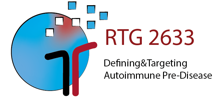Bianca Opelka

Epitope-dependent autoantibody-mediated skin inflammation in pemphigoid
Bullous pemphigoid (BP) is the most common subepidermal blistering autoimmune skin disease in patients older than 60 in Central Europe Symptoms include pruritus and bullae, which may also be preceded by erythematous or urticarial plaques. Additionally, polymorphous, annular, dark red, edematous lesions may occur. If left untreated, BP remains a potentially fatal disease.
The major autoantigen of autoantibodies in pemphigoid diseases, such as BP or even mucous membrane pemphigoid (MMP), is collagen XVII (Col XVII, BP180).
In BP, most antibodies recognize the immunodominant NC16A region of the molecule, whereas in MMP, mainly the C-terminal parts of BP180 are targeted. In addition, many patients have autoantibodies against epitopes on the C-terminus of BP180, associated with a less inflammatory phenotype and more frequent mucosal involvement.
Previous work showed that both FC-independent and -dependent effects play a role in BP pathogenicity. Treatment of human cultured keratinocytes with anti-NC16A-BP180 antibodies resulted in the release of pro-inflammatory cytokines such as IL-6 and IL-8 and internalization of BP180. In addition, the signaling pathways and phosphorylated kinases (p70S6 kinase, RSK1/2/3, p38a, JNK1/2/3, and HSP27) that play a role in modulating cell cycle progression, cell size, cell survival, cell growth, cell motility, cell proliferation, differentiation, migration, transformation, and apoptosis were identified. In addition, using the ex-vivo cryosection model, cleavage was observed in sections of human skin after incubation with sera from BP patients followed by incubation with isolated neutrophils. In addition, various mouse models have been used to further elucidate the pathogenesis of BP.
In this work, we aim to verify whether the epitope specificity of autoantibodies against the same autoantigen has a critical impact on the inflammatory response at a time point prior to the appearance of skin/mucosal lesions.
To this end, we will demonstrate differences in cellular events immediately following binding of IgG antibodies to different epitopes on BP180 from patients with active disease and in remission, as well as from healthy individuals with BP180 antibodies in-vitro. To achieve this, different proteins (BP230, BP180 ICD, NC16A, NC1-15) will be produced for immunization of rabbits and specific affinity purification of IgGs (rabbit and human). These various purified antibodies/autoantibodies will be used to treat cultured human keratinocytes. The effect of the different antibodies will be analyzed by transcriptome analysis and proteomics/phospho-proteomics. In addition, the release of cytokines will be measured and compared. To validate these results, qRT-PCR, Western blotting and ELISA will be performed. The next step will be the specific inhibition of the identified cellular events e.g. by signal transduction inhibitors, receptor blockers, small molecules or by siRNA.
Complementary, in-vivo analysis of the effects of the epitope-specific antibodies will be performed in mouse models by checking the clinical phenotype, analyzing the transcriptome in case of striking effects on skin and mucosa (lesional and perilesional skin/mucosa) and applying the in-vitro identified inhibitors.

- People
- Doctoral Candidates
- Merabell Adem
- Katja Adriany
- Farbod Bahreini
- Estelle Bergmann
- Swayanka Biswas
- Jana Buhre
- David De Luca Laredo
- Kaan Ersoy
- Ferdinand Gebauer
- Sen Guo
- Veronika Hartmann
- Michelle Hein
- Luise Janusch
- Maj Jäpel
- Anna Knauer
- Valentin Kneitz
- Maximilian Lahmer
- Wing Yu Lee
- Daniel Mehlberg
- Sahar Mehrabani
- Afsaneh Mehrpouyan
- Sadegh Mousavi
- Milica Novovic
- Justus Ohmes
- Bianca Opelka
- Colin Osterloh
- Cristian Papara
- Tina Rastegar Lari
- Rochi Saurabh
- Alessia Maria Sbaraglia
- Jovan Schanzenbacher
- Mareile Schlotfeldt
- Carolin Schmidt
- Solveig Lea Schmidt
- Leon Schmidt-Jiménez
- Nora Schoell
- Salomini Sinnathurai
- Sarah Stenger
- Chiara Walczyk
- Nele Wellbrock
- Julia Wimmer-Gross
- Natalia Zappe
- Jianrui Zheng
- Luca Zillikens
- Carla Zünkeler
- Principal Investigators
- Associated Scientists
- Administration
- Doctoral Candidates



